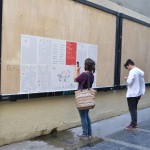Charles Jencks, David Kohn, Seyla Benhabib and Merve Kaptan have sent their letters to Istanbul for the fifth issue of the NCR.

Istanbul – The Time City
Istanbul and Rome are the quintessential time cities of the world, with layers of history going back thousands of years, marked in stone structures and excavations. But in one way the Turkish city, and the country as a whole, has an even bigger claim to be the historical, layered site of the globe going back further than Rome.
Turkey has some of the first Neolithic sites in the world, such as Catalhöyük, where the town came into being, and Göbekli Tepe, the 12,000 year old site which is revolutionizing our view of what caused the first urban society. The Neolithic Period came about not just because of the revolution that started agriculture – the mutation in wheat that allowed people to collect into towns and live off farming, but for another surprising reason. They came together to worship, or at least build haunting architectural monuments laid out in concentric circles. Göbekli Tepe, excavated over the last seventeen years, was made from T-shaped monoliths carved with sculptures and bas-reliefs of animals. Most are ferocious predators baring their teeth, and they look as uncanny as the long arms, and thin fingers that turn each T-shape into a giant human figure. Generations at Göbekli Tepe built one circle of T’s inside or around another at great human effort. Some of the monoliths are comparable to those at Stonehenge. The ritual underpinning this collective belief is now mysterious to us, but archaeologists and anthropologists are calling the creations “the birth of religion” because they entailed a strong social cohesion. No evidence of houses survive, the farming communities must have lived nearby. Twelve thousand years ago the Neolithic Revolution apparently started partly because of this “oldest known temple site,” and Istanbul has evidence of habitation at least as long.
What are the implications for new building in such areas? A Time City is a layered amalgam of different ages and, like a geological section through a mountain, reveals its levels as different materials, colours and chemistries. In effect, these levels show a naturalistic picture of history, an indexical sign of time, and a palimpsest of cultures. To build in the Time City of Istanbul is to protect and dramatise this layering. Where construction is over new landscape or infill, it is to simulate the layering as an artificial construct. The Time City is constructed by the ages; the architect brings to consciousness evolution, destruction and the re-minting of coins – the palimpsest.
(Layered Walls of Theodosius….and The New Artificial Walls)
Charles Jencks
[ Read more ]






















